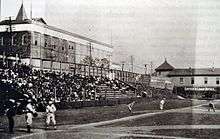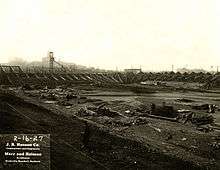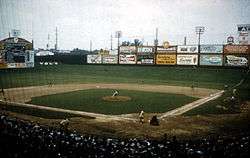Sulphur Dell
| Suffer Hell | |
|
Sulphur Dell, with the famous right field incline visible | |
| Former names |
Sulphur Springs Ball Park (c. 1850s–60s) Athletic Park (1870–1908) |
|---|---|
| Location |
900 Fifth Avenue North Nashville, Tennessee |
| Coordinates | 36°10′23.31″N 86°47′7.39″W / 36.1731417°N 86.7853861°WCoordinates: 36°10′23.31″N 86°47′7.39″W / 36.1731417°N 86.7853861°W |
| Capacity |
2,500 (1901)[1] 7,000 (1927)[2] 8,000 (1932)[3] 8,500 (1938)[2] |
| Field size |
1885–1926: Left Field: 362 ft (110 m) Center Field: 485 ft (148 m) Right Field: 362 ft (110 m) 1927–1963: Left Field: 334 ft (102 m) Center Field: 421 ft (128 m) Right Field: 262 ft (80 m) |
| Surface | grass |
| Construction | |
| Opened | 1870 |
| Renovated | 1885, 1897, 1908, 1927, 1951 |
| Expanded | 1920, 1938 |
| Closed |
September 7, 1963 (last Vols game) |
| Demolished | April 16, 1969 |
| Architect | Marr and Holman (1927)[2] |
| General contractor | J. B. Hinson Co. (1927)[2] |
| Tenants | |
| |
Sulphur Dell was a minor league baseball park in Nashville, Tennessee. Originally known as Sulphur Springs Ball Park and later Athletic Park, it was used for baseball for nearly 100 years, from 1870 to 1963. Its longest tenant was the Southern Association's Nashville Vols, who played there from 1901 to 1963. The ballpark, demolished in 1969, was located in the block bounded by present-day Jackson Street, Fourth Avenue North, Harrison Street, and Fifth Avenue North. First Tennessee Park, a new ballpark which opened on April 17, 2015, was built for the Nashville Sounds Triple-A team on the site of the original ballpark.
History
Early history (1850s–1884)
Sulphur Springs Ball Park, as it was first known, was located in an area referred to by early settlers as French Lick Springs.[4] Pioneers came to this bottomland, or dell, for trading and watering at a natural sulphur spring. Also known as Sulphur Springs Bottom, this later became a popular area for picnicking and recreation.[4]
Nashvillians started playing baseball as early as the 1850s.[5] Many local amateur baseball teams played their games at Sulphur Springs Bottom. In order to meet the city's need for a dedicated baseball field, a portion of the dell was designated for this purpose and called Sulphur Springs Ball Park.[6] By 1870, the baseball grounds were referred to as Athletic Park.[5]
Sulphur Dell I (1885–1926)

In 1885, the Nashville Americans minor league baseball team became charter members of the newly formed Southern League.[7] Athletic Park, which had hitherto been little more that solely a baseball field, required improvements to make it suitable for professional teams.[6] A 150-foot (46 m) wooden grandstand was built at the corner of modern-day Fourth Avenue North and Jackson Street.[6] The main Jackson Street entrance led past the ticket booth and into the grandstand's reserved seats behind home plate and a screen backstop.[6] Rooms for players, directors, scorers, and reporters were built under the grandstand. Two of them had views of the field, which were protected by wire screens. Restrooms and water fountains, which pumped up sulphur water from the springs below, were also built.[6] The distance to the outfield fence was 362 feet (110 m) to left and right fields and 485 feet (148 m) to center.[6]
Prior to the start of the season, the Nashville Americans hosted the National League's Chicago White Stockings for three weeks of spring training. Chicago competed in exhibition games against the Americans, local semi-pro clubs, and the Vanderbilt Commodores baseball team.[7] The Americans played their first regular season home game on May 4 against the Columbus Stars. Nashville lost the contest, 2–3.[7]
The ball park was built with hosting other sporting events in mind. A bicycling and running track measuring 150 yards (137 m) was constructed around the outfield.[6] On Thanksgiving Day in 1885, Nashville's first organized football game was held at Athletic Park. The Nashville Football Club defeated the Nashville Athletic Club, 6–4.[6]
The Americans played another season in 1886, but dropped out of the league after the season. They would be followed by the Nashville Blues (1887), Nashville Tigers (1893–94), Nashville Seraphs (1895), and Nashville Centennials (1897) as 19th century tenants of Athletic Park.[8] The bleachers along the third base line were replaced by seats in 1897.[1] In 1901, the newly formed Southern Association's Nashville Vols began playing their home games at the ballpark.[9] The capacity was expanded to 2,500, with 1,000 seats in the grandstand, before the Vols' first season.[1] The semi-pro Negro league Nashville Elite Giants, a forerunner to the Nashville Standard/Elite Giants, started playing games at Athletic Park as early as 1907.[10] The team remained at the park through 1928 when Tom Wilson Park was built for the team by their owner.[11]
On July 4, 1894, Nashville and the Macon Hornets were scheduled to play a night game at Athletic Park. This was long before ballparks were equipped with electric lights, and night games were seen only as gimmicks. To put time into perspective, the first major league night game was not played until over 40 years later in 1935.[12] The game was rained out twice, but finally rescheduled for July 6 as a tripleheader against the New Orleans Pelicans. The first two games would be played during the day, with the special night game to be played that evening.[13]
The teams split the day-doubleheader, each winning one game. That evening, 54 large electric lights were placed around Athletic Park to light the field; the baseball was also covered with phosphorus to aid visibility.[13] Adding to the novelty of a night game, players came onto the field wearing costumes that included grass skirts, ballet costumes, loud suits, bonnets, and dresses.[13] The decidedly unusual contest drew an estimated 4,000 spectators; typical games drew only a few hundred.[13] Nashville won the game by a score of 3–2.[13] This marked the first time that a night baseball game was played in Nashville. This feat is often incorrectly attributed to the Nashville Vols in 1931.[13]
Nashville Tennessean sportswriter Grantland Rice started referring to the ballpark as "Sulphur Spring Dell" in 1908.[10] A new grandstand was built that same year.[3] He later shortened this name to "Sulphur Dell", and the name stuck with the ballpark through its 1969 demolition and beyond.[10]
In 1920, the grandstands were expanded further west on Jackson Street and further south on Fourth Avenue North.[14]
Sulphur Dell II (1927–1963)


The original grandstand at Sulphur Dell was situated with home plate facing the southwest toward the Tennessee State Capital building.[5] Consequently, batters would often have to compete with the afternoon sunlight shining in their eyes. After the 1926 season, the entire ballpark was demolished and rebuilt as a concrete-and-steel structure with home plate facing northeast along Fourth Avenue North.[5]
Sulphur Dell's infamous outfield was born out of this realignment. The new distances to the park's outfield walls were 334 feet (102 m) to left field, 421 feet (128 m) to center, and 262 ft (80 m) to right.[5] Even with such a short distance to right field, the ballpark had a significant "terrace" or sloping outfield: a steep incline that ran along the entire outfield wall, most dramatically in right and center fields.[5] The top of the right field terrace was 22½ feet (7 m) above the infield.[5] Right fielders were often called "mountain goats" because they had to go up and down the hills in right-center and right. They usually played on the 10-foot-wide "Shelf" one-third of the way up the incline. Occasionally, the Shelf was used for overflow seating, cutting the already-short right field distance to 235 ft (72 m).[15]
The wooden outfield fence was 16 feet (5 m) high. The 186 foot (57 m) fence ran from the right field foul pole toward center field, where the fence was topped with a 30 foot (9 m) screen that decreased to 22 1/2 feet (7 m) high where it terminated in center field.[5] A manually operated scoreboard was installed in left-center field that jutted out onto the field creating two unusually angled corners in which outfielders had to field balls.[16] The seating capacity of the turned-around stadium was 7,000.[2] Seats were painted green, except for reserved seats which were painted orange.[17] The first game at the reconfigured ballpark was an exhibition contest against the American Association's Minneapolis Millers, a 5–3 loss for the Vols.[3]
The ballpark was nicknamed "Suffer Hell" by fielders who had to navigate the treacherous outfield,[8] as well as by pitchers who frequently watched home runs disappear over the short fences.[18] The park was also nicknamed "the Dump" because of the odor that drifted in from the nearby city dump.[15] Babe Ruth, who came to the Dell for an exhibition game with the New York Yankees against the Vols, reportedly refused to play right field and was moved to left field for the game.[8]
Located roughly a quarter mile from the Cumberland River, it was prone to flooding early in the season. The Vols frequently had to cancel or reschedule games or move them to Vanderbilt's McGugin Field. Even when the field was playable after heavy rain, the conditions led players to liken the field to "a drained-out washtub."[19] The stands were very close to the field. First base was only 42 feet from the stands, leading Casey Stengel to joke that he could bunt a home run down the first base line. Third base was even closer, at 26 feet.[15]
Lights were added to the ballpark in 1931, and on May 18, the Vols played their first night game against the Mobile Marines.[20] Nashville lost the contest, 8–1.[20] In 1938, the seating capacity was expanded to 8,500.[2]
In addition to the Vols playing their home games at Sulphur Dell, the minor Negro league Nashville Stars played there in 1942, as well as the Nashville Black Vols/Cubs from 1945 to 1951.[21]
In 1951, the ballpark was updated with a remodeled facade, new turnstiles, brick walls, wider exits, and other improvements.[10] The new front entrance had a marque which read, "Sulphur Dell, Baseball's Most Historic Park Since 1870".[22] Ownership of the Nashville Vols was transferred to a public corporation, Vols, Inc., led by Herschel Lynn Greer in 1959.[23] Prior to the start of that season, an organist's booth was built next to the press box, seats were repaired and repainted, and other general repairs were made.[23]
The last Nashville Vols games, the last professional baseball games to be played at Sulphur Dell, were played on September 8, 1963.[10] The Vols had joined the Double-A South Atlantic League after the Southern Association folded after the 1961 season and the team was inactive in 1962. In the doubleheader, the Vols defeated the Lynchburg White Sox in both games, 6–3 and 2–1.[10] The Vols disbanded for good after the 1963 season.
Final years (1964–1969)
Amateur baseball teams played at Sulphur Dell in 1964. The park was converted to a speedway for three weeks in 1965. The stadium then served as a tow-in lot for Metro Nashville, before being demolished on April 16, 1969.[24] The remains of the recently demolished Andrew Jackson Hotel were used to fill in the site.[1] It then became the location of a number of parking lots north of the Tennessee State Capitol until 2014. The site was also bisected by a stretch of the Music City Bikeway cycle path.
Baseball returns (2015)

In August 2013, the city of Nashville was announced to be in negotiations with the State of Tennessee, which then owned the former Sulphur Dell property, to build a new minor league stadium at this location to serve as the new home to the Nashville Sounds, a minor league baseball team of the Triple-A Pacific Coast League.[25] On November 8, 2013, a deal was agreed upon to build a new ballpark at Sulphur Dell.[26] The plan received final approval from Nashville and State of Tennessee officials on December 10, 2013.[27]
The stadium, First Tennessee Park, was built on the former site of Sulphur Dell and replaced Herschel Greer Stadium, the Sounds' home ballpark since 1978.[28] The stadium holds up to 10,000 people, with 8,500 of that in fixed seating and the rest in open areas, such as grass berms.[29][30] The cost of the entire development, including commercial and retail space, a greenway, and a parking garage, is approximately $150 million; the stadium itself costs $47 million.[31][32][33] The new stadium opened on April 17, 2015.[34] In the ballpark's inaugural game, the Sounds defeated the visiting Colorado Springs Sky Sox, 3–2 in 10 innings.[35]
All-Star Games
Sulphur Dell hosted the Southern Association All-Star Game on five occasions. Not only were the games held at Nashville's ballpark, but the Vols also served as the All-Star team's competition.[36]
| Date | Winning team | Score | Losing team | Attendance |
|---|---|---|---|---|
| July 8, 1940 | All-Stars | 6–1 | Nashville Vols | 5,500 |
| July 9, 1943 | Nashville Vols | 3–2 | All-Stars | — |
| July 20, 1948 | Nashville Vols | 4–3 | All-Stars | 9,147 |
| July 12, 1949 | All-Stars | 18–6 | Nashville Vols | 11,442 |
| July 17, 1957 | All-Stars | 7–6 | Nashville Vols | — |
References
- General
- Nipper, Skip (2007). Baseball in Nashville. Arcadia Publishing. ISBN 978-0-7385-4391-8.
- Specific
- 1 2 3 4 Nipper, Skip (March 16, 2015). "Nashville Bugs, Builders, and Ballpark Construction". 262 Down Right. Retrieved April 13, 2015.
- 1 2 3 4 5 6 Baseball in Nashville, p. 40
- 1 2 3 Ammenheuser, David. "Coming Home to Sulphur Dell". The Tennessean. Retrieved April 11, 2015.
- 1 2 Nipper, Skip (November 5, 2013). "Salt and Sulphur". 262 Down Right. Retrieved February 6, 2015.
- 1 2 3 4 5 6 7 8 Nipper, Skip (January 4, 2014). "Sulphur Dell: A Brief History". 262 Down Right. Retrieved February 6, 2015.
- 1 2 3 4 5 6 7 8 Traughber, Bill (June 25, 2012). "Looking Back: Nashville's Sulphur Springs Ballpark". Nashville Sounds. Minor League Baseball. Retrieved February 6, 2015.
- 1 2 3 Traughber, Bill (April 25, 2011). "Looking Back: The 1885 Nashville Americans". Nashville Sounds. Minor League Baseball. Retrieved February 6, 2015.
- 1 2 3 Nipper, Skip (January 30, 2014). "Bleachers in the Sun". 262 Down Right. Retrieved February 6, 2015.
- ↑ Traughber, Bill (May 23, 2011). "Looking Back: The 1901 Nashville Vols". Minor League Baseball. Retrieved February 2, 2015.
- 1 2 3 4 5 6 Nipper, Skip (January 14, 2015). "Grantland Rice Named "Sulphur Dell" On This Day". 262 Down Right. Retrieved February 6, 2015.
- ↑ "Tom Wilson Park Marker". The Historical Marker Database. Retrieved February 6, 2015.
- ↑ "Night Baseball Arrives in the Majors". Crosley Field. Retrieved January 29, 2015.
- 1 2 3 4 5 6 Traughber, Bill (August 4, 2008). "Looking Back: Nashville Plays Night Baseball In 1894". Nashville Sounds. Minor League Baseball. Retrieved October 8, 2008.
- ↑ Baseball in Nashville, p. 22
- 1 2 3 Lowry, Phillip (2005). Green Cathedrals. New York City: Walker & Company. ISBN 0-8027-1562-1.
- ↑ Baseball in Nashville, p. 43
- ↑ Baseball in Nashville, p. 46
- ↑ Sulphur Dell entry at Tennessee State Library and Archives
- ↑ Sulphur Dell timeline
- 1 2 Traughber, Bill (June 21, 2010). "Looking Back: Sulphur Dell's First Night Game". Nashville Sounds. Minor League Baseball. Retrieved February 7, 2015.
- ↑ Nipper, Skip (December 12, 2013). "Baseball Shrines". 262 Down Right. Retrieved February 6, 2015.
- ↑ Baseball in Nashville, p. 45
- 1 2 Nipper, Skip (December 21, 2013). "Changes in Store at Sulphur Dell for 1959". 262 Down Right. Retrieved March 24, 2015.
- ↑ Traughber, Bill (August 26, 2013). "Looking Back: Sulphur Dell Demolished in 1969". Minor League Baseball. Retrieved February 6, 2015.
- ↑ Rau, Nate; Garrison, Joey (21 Aug 2013). "$80 million new Sounds stadium project at Sulphur Dell in the works". The Tennessean. Retrieved 22 Aug 2013.
- ↑ Farmer, Blake (8 Nov 2013). "We Have A Deal: Governor, Mayor, Sounds Agree On New Baseball Stadium". WPLN News. Retrieved 8 Nov 2013.
- ↑ Cass, Michael (11 Dec 2013). "Metro Council approves Nashville Sounds ballpark deal". The Tennessean. Retrieved 11 Dec 2013.
- ↑ "Ballpark at Sulphur Dell". Metropolitan Government of Nashville and Davidson County, Tennessee. 12 Dec 2013. Retrieved 12 Dec 2013.
- ↑ Hale, Steven (25 Oct 2013). "City reveals details about Sulphur Dell stadium". NashvillePost.com. Retrieved 12 Dec 2013.
- ↑ Farmer, Blake (22 Apr 2014). "New Sounds Stadium Will Be Called First Tennessee Park". WPLN News. Retrieved 22 Apr 2014.
- ↑ Garrison, Joey (March 18, 2015). "Nashville Sounds Stadium to Cost $10M More Than Expected". The Tennessean. Nashville. Retrieved March 19, 2015.
- ↑ "Fact Sheet – Sulphur Dell Ballpark Proposal". Metropolitan Government of Nashville and Davidson County, Tennessee. 11 Nov 2013. Retrieved 12 Dec 2013.
- ↑ Hale, Steven (11 Dec 2013). "Council Signs Off on Sounds Stadium at Sulphur Dell". Nashville Scene. Retrieved 12 Dec 2013.
- ↑ Arnold, Sky (April 17, 2015). "Nashville Sounds Opening Day at First Tennessee Park". WZTV. Nashville. Retrieved April 18, 2015.
- ↑ "Sounds Walk-Off in Home Opener". MILB.com. April 18, 2015. Retrieved April 18, 2015.
- ↑ Nipper, Skip (July 12, 2015). "Nashville Hosted Southern Association All Star Games". 262 Down Right. Retrieved May 14, 2016.
External links
| Wikimedia Commons has media related to Sulphur Dell. |
- Baseball Historian Skip Nipper's Sulphur Dell website
- Project Ballpark profile
- The Tennessee Encyclopedia of History and Culture entry
